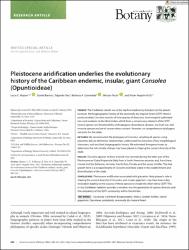Mostrar el registro sencillo del ítem
Pleistocene aridification underlies the evolutionary history of the Caribbean endemic, insular, giant Consolea (Opuntioideae)
| Autor | Majure, Lucas Charles | |
| Autor | Barrios, Duniel | |
| Autor | Díaz, Edgardo | |
| Autor | Zumwalde, Bethany A. | |
| Autor | Testo, Weston | |
| Autor | Negrón-Ortíz, Vivian | |
| Fecha de admisión | 2024-06-28T22:49:48Z | |
| Fecha disponible | 2024-06-28T22:49:48Z | |
| Año | 2021 | |
| Citación | Majure, L. C., Barrios, D., Díaz, E., Zumwalde, B. A., Testo, W., & Negrón‐Ortíz, V. (2021). Pleistocene aridification underlies the evolutionary history of the Caribbean endemic, insular, giant Consolea (Opuntioideae). American Journal of Botany, 108(2), 200-215. Recuperado de: | es |
| URI | https://bvearmb.do/handle/123456789/4794 | |
| Sinopsis | Premise: The Caribbean islands are in the top five biodiversity hotspots on the planet; however, the biogeographic history of the seasonally dry tropical forest (SDTF) there is poorly studied. Consolea consists of nine species of dioecious, hummingbird-pollinated tree cacti endemic to the West Indies, which form a conspicuous element of the SDTF. Several species are threatened by anthropogenic disturbance, disease, sea-level rise, and invasive species and are of conservation concern. However, no comprehensive phylogeny yet exists for the clade. Methods: We reconstructed the phylogeny of Consolea, sampling all species using plastomic data to determine relationships, understand the evolution of key morphological characters, and test their biogeographic history. We estimated divergence times to determine the role climate change may have played in shaping the current diversity of the clade. Results: Consolea appears to have evolved very recently during the latter part of the Pleistocene on Cuba/Hispaniola likely from a South American ancestor and, from there, moved into the Bahamas, Jamaica, Puerto Rico, Florida, and the Lesser Antilles. The tree growth form is a synapomorphy of Consolea and likely aided in the establishment and diversification of the clade. Conclusions: Pleistocene aridification associated with glaciation likely played a role in shaping the current diversity of Consolea, and insular gigantism may have been a key innovation leading to the success of these species to invade the often-dense SDTF. This in-situ Caribbean radiation provides a window into the generation of species diversity and the complexity of the SDTF community within the Antilles. | es |
| Idioma | English | es |
| Publicado | American Journal of Botany, 108(2), 200-215 | es |
| Derechos | © 2021 Botanical Society of America. Available at: https://bsapubs.onlinelibrary.wiley.com/ | es |
| Materia | Biodiversidad - República Dominicana | es |
| Materia | Flora ─ República Dominicana | es |
| Materia | Hábitats y especies | es |
| Título | Pleistocene aridification underlies the evolutionary history of the Caribbean endemic, insular, giant Consolea (Opuntioideae) | es |
| dc.identifier.doi | https://doi.org/10.1002/ajb2.1610 | |
| Tipo de material | Article | es |
| Tipo de contenido | Scientific research | es |
| Acceso | Open | es |
| Audiencia | Technicians, professionals and scientists | es |
Ficheros en el ítem
Este ítem aparece en la(s) siguiente(s) colección(es)
-
Investigación ambiental [1725]


